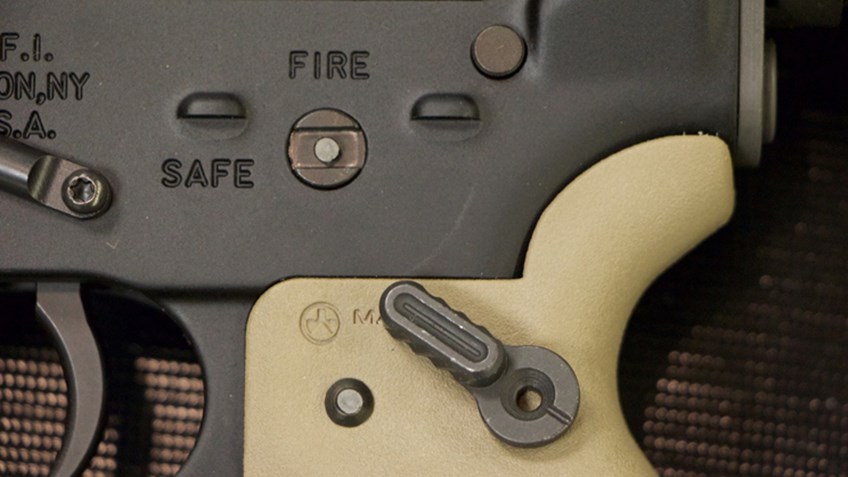Alllen Bundy
Member
The Sig P365 series, being designed for concealability, has controls of a minimum practical size. But this doesn't work well for everyone and it is not needed for all carry methods. Sig and other companies make larger magazine release buttons, and a larger and longer slide catch lever. But no company appears to be making a larger manual trigger safety lever that I am aware of.
Some people have modified their safety levers by brazing on a piece of stainless steel to make the lever larger and easier to operate.
See this earlier discussion:
I didn't think that I needed an extended manual trigger safety lever until I actually tried it and now I do NOT want to go back to the original small sized lever ever again. My carry methods will easily tolerate a manual trigger safety lever that protrudes further outward.
I plan to eventually braze a piece of stainless steel onto my manual trigger safety levers. However that is a tricky operation and I want to get it right the first time. So I have been experimenting with the shape and size of the lever by adding JB Weld epoxy to the stock lever. JB Weld epoxy can easily be sanded to shape. If I screw up and remove too much epoxy, I can just add more epoxy and sand it to shape again as many times as necessary until I get it right. Then I'll try to recreate the size and shape of the lever with stainless steel and braze it onto the stock lever using 56% silver brazing rod.
There are very often physical limitations upon where a control may be placed on the pistol. As such, more often than not, WE need to adapt to the pistol as best we can. Everyone's hands are different and it is to be expected that one size and shape manual trigger safety lever will not fit all needs.
This is what I have done so far:
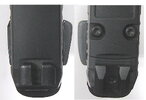
The stock manual trigger safety lever is on the far left on the P365 and it protrudes about 0.111". My first try adding epoxy to the right side lever on my P365 and it protrudes about 0.211". My second try adding epoxy to the left side lever of my P365XL and it protrudes about 0.210". For reference, the slide takedown lever protrudes about 0.103". The stock slide catch lever protrudes about 0.104". The XMacro slide catch lever protrudes about 0.171".
I can easily manipulate either of these extended manual trigger safety levers and it is a huge improvement for my thumb vs the stock size lever. Either shape will still fit into my holsters without causing any problems. However, I'm sure that I can reduce the amount of lever protrusion and still be able to easily manipulate the lever. I will probably reduce the protrusion to about 0.170", like the XMacro slide catch lever.

This photo shows all 3 controls from the top. This P365XL is also fitted with a longer XMacro magazine catch lever. FYI, I don't think that the additional protrusion of the slide catch lever helps as much as it's extra leverage from it's longer length does.
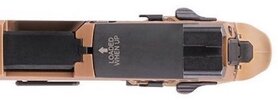
Compare to a P320 M18. I adjusted the photos to the same scale as best I could. The P320 is about 17.7% wider than the P365.
Calculating from the photo, the P320's safety lever appears to protrude about 0.292". Relatively speaking, the 0.211" protrusion of the safety lever on my P365XL is not even close to being extreme.
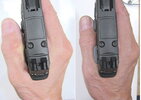
On the left you can see my thumb disengaging the safety lever. On the right I am engaging the safety lever. I have very long thumbs and I am basically manipulating the safety lever with the knuckle of my thumb. With this safety lever extension I can easily disengage and engage the safety lever without relaxing my grip on my pistol.
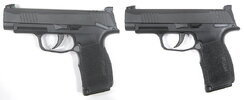
To hold the epoxy in place while it is curing, I shrunk a piece of heat shrink tubing over a deep well socket of the right size, let it cool and removed it. I then forced the tubing over the manual safety lever and then added the epoxy and let it cure. The biggest problem is creating air bubbles in the JB weld epoxy because it's consistency is so thick. Ideally, after placing the epoxy into the form, you should place it into a vacuum chamber to remove all of the air bubbles.
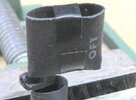
FYI, I find that pocket carry works better WITHOUT the right side manual trigger safety lever, so I cut it off. I can still actuate the left side lever manual trigger safety lever while I am holding my P365 in my left hand.
Some people have modified their safety levers by brazing on a piece of stainless steel to make the lever larger and easier to operate.
See this earlier discussion:
Sig P365 extended thumb safety
I like the little Sig P365. Weight. Capacity. Reliability. Accuracy. it’s a great little carry gun. I’m also a huge fan of Off switches on guns. I carried a 1911 for many years. Shot IPSC. So I picked up a P365 with a manual safety. As a 1911 shooter, I’ve always shot thumb high, on the...
www.thehighroad.org
I didn't think that I needed an extended manual trigger safety lever until I actually tried it and now I do NOT want to go back to the original small sized lever ever again. My carry methods will easily tolerate a manual trigger safety lever that protrudes further outward.
I plan to eventually braze a piece of stainless steel onto my manual trigger safety levers. However that is a tricky operation and I want to get it right the first time. So I have been experimenting with the shape and size of the lever by adding JB Weld epoxy to the stock lever. JB Weld epoxy can easily be sanded to shape. If I screw up and remove too much epoxy, I can just add more epoxy and sand it to shape again as many times as necessary until I get it right. Then I'll try to recreate the size and shape of the lever with stainless steel and braze it onto the stock lever using 56% silver brazing rod.
There are very often physical limitations upon where a control may be placed on the pistol. As such, more often than not, WE need to adapt to the pistol as best we can. Everyone's hands are different and it is to be expected that one size and shape manual trigger safety lever will not fit all needs.
This is what I have done so far:

The stock manual trigger safety lever is on the far left on the P365 and it protrudes about 0.111". My first try adding epoxy to the right side lever on my P365 and it protrudes about 0.211". My second try adding epoxy to the left side lever of my P365XL and it protrudes about 0.210". For reference, the slide takedown lever protrudes about 0.103". The stock slide catch lever protrudes about 0.104". The XMacro slide catch lever protrudes about 0.171".
I can easily manipulate either of these extended manual trigger safety levers and it is a huge improvement for my thumb vs the stock size lever. Either shape will still fit into my holsters without causing any problems. However, I'm sure that I can reduce the amount of lever protrusion and still be able to easily manipulate the lever. I will probably reduce the protrusion to about 0.170", like the XMacro slide catch lever.

This photo shows all 3 controls from the top. This P365XL is also fitted with a longer XMacro magazine catch lever. FYI, I don't think that the additional protrusion of the slide catch lever helps as much as it's extra leverage from it's longer length does.

Compare to a P320 M18. I adjusted the photos to the same scale as best I could. The P320 is about 17.7% wider than the P365.
Calculating from the photo, the P320's safety lever appears to protrude about 0.292". Relatively speaking, the 0.211" protrusion of the safety lever on my P365XL is not even close to being extreme.

On the left you can see my thumb disengaging the safety lever. On the right I am engaging the safety lever. I have very long thumbs and I am basically manipulating the safety lever with the knuckle of my thumb. With this safety lever extension I can easily disengage and engage the safety lever without relaxing my grip on my pistol.

To hold the epoxy in place while it is curing, I shrunk a piece of heat shrink tubing over a deep well socket of the right size, let it cool and removed it. I then forced the tubing over the manual safety lever and then added the epoxy and let it cure. The biggest problem is creating air bubbles in the JB weld epoxy because it's consistency is so thick. Ideally, after placing the epoxy into the form, you should place it into a vacuum chamber to remove all of the air bubbles.

FYI, I find that pocket carry works better WITHOUT the right side manual trigger safety lever, so I cut it off. I can still actuate the left side lever manual trigger safety lever while I am holding my P365 in my left hand.
Last edited:


